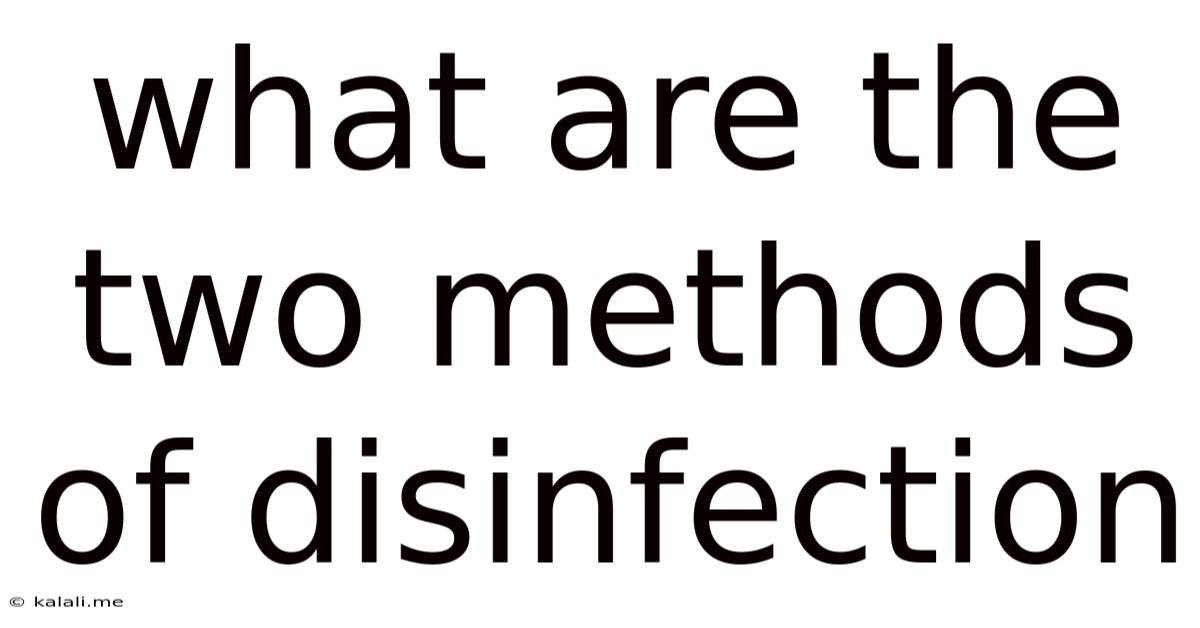What Are The Two Methods Of Disinfection
Kalali
Jun 11, 2025 · 4 min read

Table of Contents
The Two Main Methods of Disinfection: A Comprehensive Guide
Disinfection is a crucial process for eliminating harmful microorganisms like bacteria, viruses, fungi, and protozoa from surfaces, objects, and even water. Understanding the different methods employed is essential for maintaining hygiene and preventing the spread of infectious diseases. While numerous disinfection techniques exist, they broadly fall under two primary methods: physical disinfection and chemical disinfection. This article delves into each method, explaining their mechanisms, applications, and limitations.
What is Disinfection? Disinfection is the process of reducing the number of pathogenic microorganisms to a level that poses minimal risk of infection. It's important to note that disinfection differs from sterilization, which aims for the complete elimination of all microorganisms, including spores.
1. Physical Disinfection Methods
Physical disinfection methods utilize physical agents like heat, radiation, and filtration to inactivate or eliminate microorganisms. These methods are often effective, reliable, and leave no chemical residue, making them suitable for various applications.
a) Heat Disinfection:
Heat is one of the oldest and most reliable methods of disinfection. It works by denaturing proteins and disrupting the cellular structure of microorganisms, rendering them inactive or dead.
- Moist Heat: Moist heat, such as steam under pressure (autoclaving), is highly effective and is widely used in medical and laboratory settings for sterilizing equipment and materials. Boiling water can also provide effective disinfection for many items.
- Dry Heat: Dry heat, such as using an oven, requires higher temperatures and longer exposure times compared to moist heat to achieve the same level of disinfection. This method is often used for glassware and metal instruments.
- Pasteurization: This method uses controlled heating to reduce the microbial load in liquids like milk, without significantly altering its flavor or nutritional value.
b) Radiation Disinfection:
Radiation uses electromagnetic waves or energetic particles to damage the DNA of microorganisms, preventing their replication and survival.
- Ultraviolet (UV) Radiation: UV radiation is effective against a broad range of microorganisms and is commonly used for disinfecting surfaces, air, and water. However, it's less effective against shadowed areas and spores.
- Ionizing Radiation: Ionizing radiation, such as gamma rays and X-rays, is a more potent method used for sterilizing medical devices and other materials. This method requires specialized equipment and safety precautions.
c) Filtration Disinfection:
Filtration involves physically removing microorganisms from liquids or gases by passing them through a filter with pores small enough to trap the microbes. This method is particularly useful for heat-sensitive liquids and gases. Different filter types exist, catering to various particle sizes and applications.
2. Chemical Disinfection Methods
Chemical disinfection involves using chemical agents to kill or inhibit the growth of microorganisms. These agents work through various mechanisms, including disrupting cell membranes, denaturing proteins, or interfering with metabolic processes. The choice of chemical disinfectant depends on the target microorganisms, the surface being disinfected, and other factors.
a) Halogens:
Halogens, such as chlorine and iodine, are widely used disinfectants. They are effective against a broad spectrum of microorganisms and are relatively inexpensive. Chlorine is commonly used in water treatment, while iodine is used as an antiseptic.
b) Alcohols:
Alcohols, such as ethanol and isopropanol, are effective against bacteria and some viruses. They work by denaturing proteins and disrupting cell membranes. They are commonly used as disinfectants for skin and surfaces.
c) Phenols:
Phenols are another class of disinfectants that disrupt cell membranes and denature proteins. They are effective against a broad range of microorganisms but can be irritating to the skin.
d) Quaternary Ammonium Compounds (Quats):
Quats are cationic detergents that disrupt cell membranes and are effective against bacteria and some viruses. They are commonly used in household cleaners and disinfectants.
e) Aldehydes:
Aldehydes, such as formaldehyde and glutaraldehyde, are potent disinfectants effective against a wide range of microorganisms, including spores. However, they are toxic and require careful handling.
Choosing the Right Disinfection Method:
The selection of the most appropriate disinfection method depends on several factors, including:
- The type of microorganism to be eliminated.
- The nature of the surface or material to be disinfected.
- The level of disinfection required.
- Cost-effectiveness and availability of the method.
- Safety considerations for users and the environment.
Understanding the strengths and limitations of both physical and chemical disinfection methods is crucial for implementing effective infection control strategies across various settings. Always consult relevant guidelines and safety protocols when performing disinfection procedures.
Latest Posts
Latest Posts
-
Somebody Once Told Me That The World Was Macaroni Lyrics
Jul 02, 2025
-
How Old Are You If Born In 1993
Jul 02, 2025
-
What Is 1 4 Of 1 4 Cup
Jul 02, 2025
-
Is Keri Russell Related To Kurt Russell
Jul 02, 2025
-
What Is Half Of 1 4 Teaspoon
Jul 02, 2025
Related Post
Thank you for visiting our website which covers about What Are The Two Methods Of Disinfection . We hope the information provided has been useful to you. Feel free to contact us if you have any questions or need further assistance. See you next time and don't miss to bookmark.